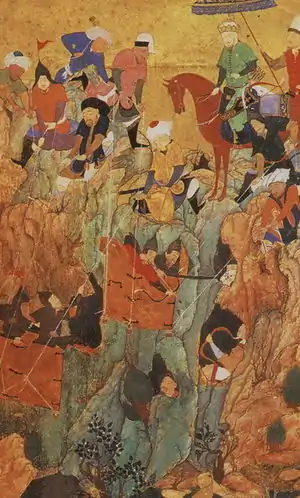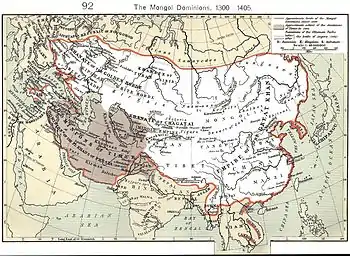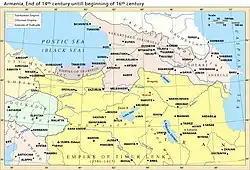| Timurid invasions of Georgia | |||||||
|---|---|---|---|---|---|---|---|
| Part of the Timurid Wars, Tokhtamysh-Timur war | |||||||
 A miniature depicting Timur's army attacking the survivors of a town in Georgia, in the spring of 1396, by the artist Kamāl ud-Dīn Behzād. | |||||||
| |||||||
| Belligerents | |||||||
|
|
| ||||||
| Commanders and leaders | |||||||
|
|
| ||||||
| Strength | |||||||
| 200,000 | 50,000 | ||||||
| Casualties and losses | |||||||
| Unknown |
Large parts of Georgia destroyed Tens of thousands civilians massacred At least 60,000 enslaved[1] | ||||||
| Part of a series on the |
| History of Georgia |
|---|
.jpg.webp) |
The Timurid invasions of Georgia[lower-alpha 1] were eight invasions between 1386 and 1403 of the Kingdom of Georgia in the Caucasus by the Timurid Empire. Led by Timur, the Timurids ultimately conquered Georgia and made it a tributary state. However, Georgia, a Christian monarchy, was allowed to retain its independence and remain Christian.
History
Timur's vast empire stretched, at its greatest extent, from Central Asia into Anatolia and these conflicts were intimately linked with the wars between Timur (Tamerlane) and Tokhtamysh, the last khan of the Golden Horde and Timur's major rival for control over the Islamic world. Although he was able to invade parts of Georgia, he was never able to make the country Muslim and even recognized Georgia as a Christian state.
In the first of eight invasions, Timur sacked Georgia's capital, Tbilisi, and captured the king Bagrat V in 1386. Georgian resistance prompted a renewed attack by the Turco-Mongol armies. Bagrat's son and successor, George VII, put up a stiff resistance and had to spend much of his reign (1395–1405) fighting the Timurid invasions. Timur personally led most of these raids to subdue the recalcitrant Georgian monarch. He was not able to establish a firm control over Georgia. By the time George VII was forced to accept Timur's terms of peace and agree to pay tribute, he was a master of little more than "gutted towns, ravaged countryside and a shattered monarchy."[2]
First invasion
Timur's first appearance in the Caucasus was a response to Khan Tokhtamysh's marauding inroad into Northern Iran through the Caucasian lands in 1385. This marked an outbreak of outright hostility between the two Islamic monarchs. Timur responded by launching a full-scale invasion of the small frontier countries, which lay between the western border of his emerging empire and Tokhtamysh's khanate. After having overrun Azerbaijan and Kars, Timur marched into Georgia. The official history of his reign, Zafarnama, represents this campaign in Georgia as a jihad. Timur set out from Kars and assailed Samtskhe, the southernmost principality within the Kingdom of Georgia later in 1386. The Tbilis fell on 22 November 1386, its inhabitants were massacred and Bagrat fell into captivity. Timur's army spent the winter in Karabakh.[1]
Liberation of Bagrat
To regain his freedom, Bagrat pretended to convert to Islam and Timur sent him back under surveillance of a 12,000 strong army which was to enforce Georgian Kingdom conversion to islam. Bagrat secretly informed his son George, who raised an army and destroyed the Timurid troops, and freeing Bagrat.[3][1]
Second invasion
Timur was very upset, but because of the middle of winter, it was impossible to march. That's why he spent the winter in Karabakh, in the early spring of 1387, in March, when it was still snowing and raining, he set out with his entire army to punish Georgia. The Georgians expected another invasion and made proper preparations. The people were stirred up in the fortresses and in the mountains of the Caucasus, and the army was also prepared for the invasion. Georgians resisted the enemy a lot and caused a lot of damage, but in the end the multitude of the army overcame and Timur won. Despite this, Timur was not able to conquer Georgia there were still many well-fortified fortresses to be captured, and Tokhtamysh army invaded Azerbaijan again through Derbent, and Timur was forced to leave Georgia. This Tokhtamish invasion, it seems, must have been agreed upon with the Georgians. Timur pursued Tokhtamish with his son, Miran Shah, who defeated Tokhtamish and expelled him from Caucasus. Then Timur tried to capture the well-fortified Alinjia fortress in Nakhchivan, but to no avail. He left part of his army at the besieged fortress, and he returned to Central Asia.
Third invasion
In 1392-1393 Timur raided and sacked the cities of Central Iran, then Baghdad, Syria, etc. In the spring of 1394, he came to southern Georgia and sent four commanders with an army of 40,000 to raid Samtskhe-Saatabago. The army returning from Samtskhe joined the main army of Timur in Kol Valley. The purpose of the invasion of Samtskhe was apparently to obtain booty and prepare the main invasion for a new, larger invasion, which took place in the fall of the same year in the Aragvi valley under the command of Timur.
Fourth invasion
On September 13, 1394, Timur invaded with a large army from the Koli valley to the Aragvi valley via Trialeti and Kvemo Kartli. On the way, he destroyed everything, robbed and killed the inhabitants. Big battles took place in Aragvi valley.toimur's goal seems to have been to capture the Darial Pass in order to ultimately prevent the withdrawal of Georgian allied North Caucasian raiders and a possible Tokhtamysh invasion. Every time Timur appeared in Georgia, Tokhtamysh tried to invade Eastern Caucasus. It happened this time as well. Timur was unable to capture Darial due to the great resistance of the mountaineers. He was forced to come down from the mountain and go to Shaki through Tbilisi. At that time, Timur learned that Tokhtamysh would invade Shirvan through Derbent and ravage the place. Timur quickly moved in this direction, but avoided the battle and turned back again. His army encamped on the banks of the Mtkvari, near Mahmud Abad, and began preparations for a great campaign against Tokhtamish. It became clear to Timur that he would not be able to subdue Caucasus, including Georgia, if he did not defeat Tokhtamysh.[1]
In the spring of 1395, Timur moved to the North Caucasus via Derbent. He found it prepared in Tokhtamysh as well. The battle took place near the Tergi River, in which Timur won. He burned and destroyed the capital of the Golden Horde, Sarai Berke, and other cities, after which he returned and attacked the peoples of the North Caucasus, who were connected with Georgia, destroyed Christian temples and forcefullyconverted them to Islam.
Timur came to Shirvan through Derbent and camped there. He gave Iran and its neighboring countries, including Georgia, to his son Miran Shah. In 1397, Tamerlane returned to Samarkand and began preparations for an invasion to India.
George VII's campaign of Azerbaijan
In 1398, Timur was engaged in a war with India. The Georgians took advantage of this. King George established an alliance with the representatives of the Jalayirid Sultanate, who were still fighting against Timur. Taher, one of the Jalairians' prince, has been under siege in Alinja prison in Nakhchivan for 10 years. The herders, who fell into extreme hardship, asked King George for help. Sayidi Ali, ruler of Shaki, also asked King George for help.
King George gathered the Georgian army, the North Caucasians were rescued and together with Sayidi Ali attacked the fortress of Alinja. King George defeated and expelled the Timurids. He strengthened the fortress with new soldiers and weapons and supplied it with food and supplies. Taher was brought to Georgia. Those who turned back were surrounded by the army sent by Miran shah. Georgians also defeated them (Sayidi Ali died in this battle).
Fifth invasion
Timur returned from the Central Asia, Timur came to Caucasus at the end of 1399 and camped in the Karabakh. Sharvanshah Ibrahim and the ruler of Shaki, Siyid Ahmed, who forgave his father's rebellion, approved him as the ruler of Shaki and ordered both of them to participate in the war against Georgia.
Timur took three chosen fighters out of every ten in his army, and thus made an army of 100,000, whom he ordered to take a 10-day march. The armies of Shirvan and Shaki were also added to them. This big army invaded Hereti and Kakheti. The purpose of this invasion was to obtain booty and food.
Timur's army invaded Hereti through a forest road. Soldiers were cutting their way with axes. It snowed continuously for 20 days. Despite this situation, Khimshia's army resisted the enemy. The battle lasted for a month. Timur's raiders looted and destroyed everything. They cut fruit trees, vineyards, walnut trees. In the end, due to the lack of fodder for cattle, they were forced to stop their march and return back during the heavy snowfall. The enemy army took a lot of property from Hereti. There were especially many flocks of sheep and herds of cattle. See also food products. The army leaving Hereti joined the main camp in Karabakh. Timur started preparations for the new sixth invasion in Georgia.
Sixth invasions
Timur spent the winter of 1399-1400 in Karabakh. After supplying food and replenishing the army, Timjr marched towards Georgia in the spring of 1400 and camped near the border. Timur sent an ambassador to King George and demanded obedience and the handing over of prince Taher. Otherwise, he threatened to destroy Georgia.
The armies of Timur and Georgians clashed at Gogchi lake. The Georgian army had a better position. It was a windy day and he was blowing dust right in the enemy's face. In the first attack, the Georgians almost completely destroyed the advance detachment of the enemy. However, Timur's army greatly outnumbered the Georgian army. In the evening, Timur attacked the Georgians, who were tired from the whole day's battle, with new large army. Georgians were forced to retreat and strengthen themselves in the mountains, fortresses and caves of Kvemo Kartli. Timur's warriors descended in front of the caves with baskets tied on ropes and shot arrows at the burning embers. This is how the mountainous part of Kvemo Kartli was identified. Then they came to Tbilisi and took it with great battles. Timur wanted to capture king George and did everything for this. He had special squads chase after George. King George was retreating with a fight. Opponents fought so close to each other that some members of George Amal were even captured by the Timurids. On the way, the enemy destroyed churches, fortresses, houses, crops, orchards. Thus they passed through Mukhran and its surroundings.
Then they invaded the area of Ksani. Eristavi Virsheli of Ksni was a participant in the Nakhchivan campaign. It seems that the prisoners brought from there were also in the Ksani valley. One of the goals of Timur's invasion of Saeristavo was to seize them. Virsheli fortified himself in Knogo prison and put up a great resistance to the attackers. The enemy did not manage to deploy a large army in the narrow valley and was forced to turn back, although he caused a lot of damage to the Ksani valley. After the Ksani valley, the Timurids invaded Kartli. Janibeg, the chief of Kartli, put up a lot of resistance, but in the end he was forced to submit, although his domain still could not escape from the destruction. There were also Muslim prisoners brought from Nakhichevan in Janibeg's domain.
The next big battle took place near the fortress of Gori. Despite the resistance of the Georgians, Timud still captured the fortress. King George was retreating again with a fight, and Timur was destroying everything on the way. Georgians defended the well-fortified Dzami fortress for seven days, after which King George was forced to leave the fortress, broke through the siege and retreated to the west. Timur's army overran the place and massacred the population mercilessly. The last battle was fought by King George against the enemy in the area of Likhi ridge. King Geomoe was forced to move to Western Georgia. Tamerlane did not dare to move to Western Georgia.
After that, he ransacked Samtskhe, robbed and robbed. They also gathered a lot of prisoners. From there, passing Trialeti, they went to Tezmi valley and looted and ransacked the place, including Rkoni monastery. Then the Kvatakhevi area was raided, and the monastery was set on fire and the people sheltering there, including monks, were burned. After that, they entered Mtskheta and looted and destroyed Svetitskhoveli. Big battles took place in Aragvi valley as well. The population of Aragvi also suffered great losses. From here, Timur marched south to the Kol field, on the way he took the fortress of Phanaskert, destroyed its surroundings and camped on the Kol field.
The invasion of 1400, which lasted the whole spring-summer, was the longest and the longest. They destroyed, looted and burned many cities and villages, castles and churches, monasteries, fields and orchards; They took 60,000 prisoners and massacred many more people. According to the historians of Tamerlane, all this happened because King George killed the Timurids besieging the Alinja fortress in Nakhichevan.[1]
Seventh invasion
After the departure of Timur from Georgia, King George moved to Eastern Georgia and began to organize domestic affairs. King George and Virshel Eristavi of Ksani raided and punished the Dvals, who took advantage of Timur's invasion and raided and looted the Ksani valley.
In 1401, after a ten-year siege, Timur's troops captured the fortress of Alinja in Nakhchivan. In the same year, Timur came to the borders of Georgia from the east and camped in Shamkor.
Konstantine Batonishvili, the ambassador of King George, offered Timur in Shamkor a truce with great gifts and in the name of the king. Tamerlane was preparing for a war against the Ottomans, and therefore a truce was desirable for him. According to the terms of the truce, Georgia paid tribute, withdrew a certain number of troops, Georgians were not supposed to harass Muslims, etc. Instead, Timur promised security to Georgia. A truce was concluded in September 1401.[4] Tamerlane stopped in Karabakh to spend the winter. In the spring, Timur's great army left for Ottomans. On the way, he came to the Tortumi fortress, in which about 200 Georgian soldiers were fortified, took it and destroyed it after a five-day battle, and cut off the soldiers.[1]
Eighth invasion
Once the Ottomans were defeated, Timur, back in Erzurum in 1402, decided to punish the king of Georgia for not having come to present his congratulations on his victory. George VII's brother, Constantine, who was then on bad terms with his brother, arrived with gifts, as did the king's defiant vassal Iwane Jaqeli, prince of Samtskhe. Sheikh Ibrahim I of Shirvan went to estimate the revenues and expenses of Georgia. George sent new presents but Timur refused them and summoned George to appear in person. In the meantime, he himself laid siege to the previously impregnable fortress of Birtvisi, defended by a tiny Georgian garrison. Having captured the fortress in August 1403, Timur sent his army to plunder and clear the frontier regions of Georgia and set out in pursuit of the retreating king George VII as far as Abkhazia. Timur's historian reports that 700 towns were destroyed and their inhabitants massacred.[1][5]


Timur only stopped his army when the ulema and the mufti decided it was possible to grant the king of Georgia clemency (aman). George VII had to pay a huge tribute, including 1,000 tankas of gold struck in the name of Timur, 1,000 horses, and a ruby weighing 18 mithkals, and in exchange Timur would recognize Georgia as a Christian kingdom and the kingdom could retain its independence. Timur then passed through Tbilisi, destroying all monasteries and churches on his way, and went to Beylagan early in 1404. All the territories from Beylagan to Trebizond were officially given by Timur as an appanage to his grandson Khalil Mirza.[1] Timur then finally left the Caucasus and headed for Central Asia, where he died on February 19, 1405, while preparing for a massive invasion of China.[6]
Aftermath
Georgia became tributary to the Timurids, Georgia was allowed to retain its independence and remain as a Christian kingdom.[2][1]
George VII's campaign against the Timurids
Timur then finally left the Caucasus and headed for Central Asia, where he died on February 19, 1405, while preparing for a massive invasion of China.[7] And the subsequent power struggles among his heirs, Timur's empire became fragmented as Miran Shah and his sons struggled over control of Persia. In the midst of this chaos, George VII, who had returned from Imereti, engaged in battles to regain lost territories. He managed to conquer Nakhchivan and Ganja while also causing destruction in places like Ani, Erzurum, and Tabriz. Despite commanding an army of merely 5,000 men, George succeeded in expanding Georgia's borders temporarily to their former extent.[8]
See also
Notes
- ↑ Georgian: თემურლენგის ლაშქრობები საქართველოში, romanized: temurlengis lashkrobebi sakartveloshi
References
- 1 2 3 4 5 6 7 8 9 Minorsky, Vladimir, "Tiflis", in: M. Th. Houtsma, E. van Donzel (1993), E. J. Brill's First Encyclopaedia of Islam, 1913–1936, p. 757. Brill, ISBN 90-04-08265-4.
- 1 2 Suny, Ronald Grigor (1994), The Making of the Georgian Nation, p. 45. Indiana University Press, ISBN 0-253-20915-3
- ↑ Baumer 2023, p. 75.
- ↑ Sicker, Martin (2000), The Islamic World in Ascendancy: From the Arab Conquests to the Siege of Vienna, p. 155. Praeger, ISBN 0-275-96892-8.
- ↑ Grousset, René (1970), The Empire of the Steppes: A History of Central Asia, pp. 433–4. Rutgers University Press, ISBN 0-8135-1304-9.
- ↑ Tsai, Shih-Shan Henry (2002). Perpetual Happiness: the Ming Emperor Yongle. Seattle: University of Washington Press. p. 161. ISBN 978-0295981246. OCLC 870409962.
- ↑ Tsai, Shih-Shan Henry (2002). Perpetual Happiness: the Ming Emperor Yongle. Seattle: University of Washington Press. p. 161. ISBN 978-0295981246. OCLC 870409962.
- ↑ Rayfield 2012, p. 152.
